Results 1-28 of 28
<<< Previous 1 Next >>>
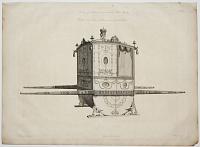
Design of a Sedan Chair as executed for Her Majesty. Dessein d’une Chaise à Porteur executée pour la Reine. Plate VI.
R. Adam Architect 1771. P. Begbie sculp.
Published as the Act directs 1773.
Engraving with small margins. Plate 444 x 591mm. 17½ x 23¼".
Design for a sedan chair; Volume I, part 5, "Works in Architecture". Robert and his brother James Adam forever changed the face of British architecture by introducing innovative Classical design ideas. From 1754-57, Robert lived in Italy where he had a long productive friendship with Piranesi, which was inspirational for both men. Upon his return, the brothers launched their career by building the Adelphi from the Thames to the Strand in London, which although not a commercial success at the time, included one of London's most cherished buildings, the Adlephi Theatre. Together, the Adam brothers designed and built some of the most famous buildings in England, including such bastions of English architecture as Kenwood House, Keddlestone Manor, and Syon House. To the interiors of their English country houses, the Adams brought wonderful ornamental elements in niches, lunettes, festoons and reliefs. Their classically designed buildings were so numerous in London that they changed the prevailing feel of the city and established their brand of neo-Classicism as the model of elegance and importance. It is asserted that the brothers originated the concept of the uniform facade attached to the typical English row house, an architectural device that distinguishes London buildings. This monumental contribution is evidenced in the Adams' designs for Portland Place and Fitzroy Square, and these were used as architectural models for the whole city. The brothers brought their talents into other areas by designing furniture to complement their beautiful interiors and by creating and publishing a treatise of design entitled 'Works in Architecture'. The work was published in three volumes over an extended span of time, beginning in 1773, with the final volume being published posthumously in 1822.
[Ref: 27736] £350.00
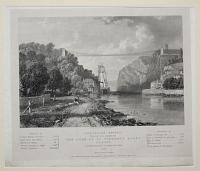
Suspension Bridge, Proposed to be erected over the Avon at St Vincent's Rocks, Clifton. By Samuel Brown, Esq.r Commander, Royal Navy. 1830.
Drawn on Stone by J.D. Harding.
London: Published by Engelmann, Gray, Coindet & Co., 14 Newman Street, & O.C. Lane, Library, Clifton, 1830.
Rare lithograph on chine collé. 235 x 280mm (9¼ x 11"), with large margins. Creasing.
A view of Clifton Gorge with a suspension bridge designed by Captain Samuel Brown (1776-1852) for the second of two design competitions, eventually won by 24-year-old Isambard Kingdom Brunel. Although Brown describes himself as Royal Navy he was already a successful enginneer, having constructed in 1820 the Union Bridge in Tweed, the longest wrought iron suspension bridge for vehicles in the world and the first in the United Kingdom.
[Ref: 47551] £260.00
(£312.00 incl.VAT)

Sauntering down Bond Street, in the evening, to "Lose & neglect the creeping hours of time," espied an acquaintance on the opposite side of the way; ever alive to the chance of a supper, darted across, when a heedless "Knight of the Whip," passing with his crazy vehicle, laid me senseless; thus convey'd to the shop of an Apothecary, was stript to ascertain where I was injured. _"When sorrows come, they come not singly handed, but in battalions.".had the moritifcation of being sufficiently sensible to be aware of the exposure of my wardrobe, without the power to prevent it, lost my supper, but gained a few bruises.
London, Published by W. Egerton, 1821.
Hand-coloured aquatint. Plate 215 x 274mm. 8½ x 10¾". Water staining to the left.
Satirical scene with in a regency Apothecary or Pharmacy with the treatment of a man who collapsed after being run down by a coach and driver. The driver stands to the right offering an explantation as to how the accident happened. Four men attend to the injured man while witnesses spy in at the window.
[Ref: 21565] £70.00
(£84.00 incl.VAT)
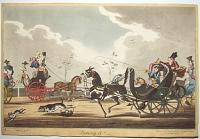
Coming it! _
I. _ etched by G. C_k.
London Pubd by G Humphrey 24 St James's Street _ Nov.r 24th 1824.
Fine coloured etching. Sheet 270 x 370mm (10½ x 14½"). Trimmed within plate.
Amateur whips, ostentatiously or ineptly negligent, drive outré vehicles with showy horses. BM Satires 14721.
[Ref: 58274] £280.00
(£336.00 incl.VAT)

Extraordinary Trotting Match Against Time. This match made against time for £100, in which Mr. Burke, of Hereford notoriety, undertook to drive two horses in the same vehicle, alternately, 45 Miles in Three successive hours, was decided on Tuesday June 25.th 1839, over 5 miles on Sunbury Common, from the Staines end to the 5 mile stone towards Hampton, which was complete in 2 hours, 55½ minutes. The wheeler, Tommy, trotted 20 miles in harness, two months previous to the above match...and now, for any sum, to the amount of £1000 Mr. B. challenges the distance of the Train from Birmingham to London, & give ½ and hour start! and the money is ready at Mr. Dowlings, Editor of "Bell's Life in London".
Painted by J.F. Herring. Engraved by Cha.s Hunt.
Published Nov.r 1.st 1839, for the Proprietor, by R. Ackermann, at his Eclipse Sporting Gallery, 191 Regent Street St. London.
Very fine and rare aquatint, printed in colours and hand finished. Visible area 590 x 775mm (23½ x 30½").
In 1839 two horses were driven in tandem trotted 45 miles of road in 2 hours 55.5 minutes. Driving this pair backwards and forwards over a measured five mile stretch of road between Hampton and Sunbury, Mr Burke of Hereford won £100 for completing the distance inside 3 hours. The horses, Tommy and Gustavus (a 24 year old), had both had won individual match races. Siltzer: p.150. Hickman: p.304.
[Ref: 24160] £1,250.00
![[St. Paul's Cathedral from Fleet Street.]](img-thumbnail/jpegs/12085.jpg)
[St. Paul's Cathedral from Fleet Street.]
Luigi Kasimir [pencil signature.]
[n.d., c.1920.]
Large coloured etching from a limited edition, numbered 177/250 in pencil. 530 x 395mm, 21 x 15½". Paper age toned. Extremities tatty, with tears and chips.
Impressive and vibrant view looking up Fleet Street and Ludgate Hill towards St Paul's Cathedral. The street id thronged with people and vehicles of all kinds. By Luigi Kasimir (1881 - 1962), world renowned Austrian-born etcher and painter, born in 1881 in Pettau, a part of the Austro-Hungarian monarchy. Kasimir attended the Vienna Academy of Art where he studied under William Unger, who introduced him to the technique of the coloured etching. Kasimir was among the first to develop the technique of the coloured etching. Prior to this, prints were usually hand coloured with the colour being applied in a casual, haphazard manner. Kasimir first did a sketch- usually in pastel. He then transferred the design on as many as four to six plates, printing one after the other and applying the colour on the plate, all done by hand. The finished etching is a true original.
[Ref: 12085] £790.00

From End to End and Back Again An Unprecedented Performance by Car, Tyres, and Drivers.
[c.1906]
Book, card wrappers with original binding, rare, 24pp., 220 x 290mm (8½ x 11½").
Account of the famous drive in June 1906, which saw Angus Shaw and Frederic Eastmead drive the Sunbeam 16/20 (the first Sunbeam designed by Shaw) from John O’Groats to Land’s End, covering 1756 miles, without stopping the engine.
[Ref: 43204] £220.00
view all images for this item
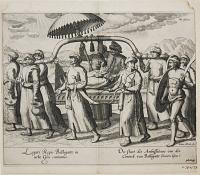
Legati Regis Ballagatte in urbe Goa comitatus. Die staet des Ambassateurs van den Coninck van Ballagatte binnen Goa.
J.v. Linchoten [monogram]. Joann à Doete: fec.
[Amsterdam, 1596.]
Scarce engraving. 255 x 320mm (10 x 12½"). Trimmed at sides to image, laid on card, old ink mss. pagination.
'The Ambassador of the King of Ballagatte in Goa', showing him in a sedan chair, surrounded by guards. Engraved by Jan van Doetechum for 'Histoire de la navigation de Jean Hugues de Linschot Hollandois', Jan Huygen van Linschoten's account of the East Indies. Known as the ''Itinerio'', this work broke the Portuguese monopoly on the trade routes to the Far East.
[Ref: 51619] £320.00
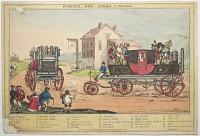
Gurney's New Steam Carriage.
[Drawn by an A]mateur.
Pub Dec 12 1827 by J. Fairburn Broadway Ludgate Hill.
Etching with fine hand colour. Sheet 255 x 375mm (10 x 14¾"). Trimmed within plate, bottom left corner lacking, affecting signature and key, hole in border and sky top left. Extremely scarce but damaged.
An image of two of Sir Goldsworthy Gurney's carriages, showing the profile and rear, with a 30-point key naming the main components. The onlookers are caricatured yokels. The Gurney Steam Carriage Company of Regent’s Park was the first commercial steam-carriage company to go into operation, in 1827. They stopped building steam carriages in 1832 because of the competition from railways. Not in BM.
[Ref: 59498] £480.00

D.r Church's London and Birmingham Steam Coach, Built at Birmingham, 1833.
John Cooke, Delin. Eng.d by Josiah Allen birm.m.
Published by Josiah Allen, Birmingham, & by Mess.rs Ackermann, Tilt & Fullers, London.
Fine & scarce steel engraving. Sheet 210 x 295mm (8¼ x 11½"). Trimmed within plate, affecting publication line.
A three-wheeled steam coach carrying passengers down a country road. There is no sign of a flue. Dr. William Church (c.1778-1863), an American inventor, patented two steam carriages, the first in 1832, which wasn't built, and a second in 1835, after which he founded the London and Birmingham Steam Carriage Company. Whether the London to Birmingham run was ever completed is uncertain, but soon Church turned his attention to designing locomotives.
[Ref: 62118] £450.00

The Southwark End of Old London-Bridge. From a Drawing taken at Low-water 25th Novr, 1831.
Drawn & Etched by Edwd. Wm. Cooke.
London Pubd.Oct, 1832 for the Proprietors by J.Brown, Old Broad Street.
Etching 315 x 405mm.
River Thames at low tide. three figures in a boat on the River Thames and horse-drawn vehicles moving across the bridge overhead.
[Ref: 1360] £160.00
(£192.00 incl.VAT)

John Loudon McAdam, Esqr.
Engraved by Charles Turner
London, Published Sep.r 20 1825 by Messrs. Colnaghi & Co. Pall Mall East
Mezzotint, proof, platemark 360 x 250mm (14¼ x 9¾") very large margins.
John Loudon McAdam (1756-1836), builder and administrator of roads. Based in Bristol, McAdam developed a new method of road construction involving the preparation of a well-drained subsoil and foundations of small, angular stones applied to a depth of 10 inches and compressed by workmen. After successfully working as general supervisor to the Bristol Turnpike trust, McAdam and his family were engaged as consultants to many other trusts (by the time of his grandson's death in 1861 the McAdam family were consultants to almost 150 trusts). Such was McAdam's significance that his name has become part of standard English usage, with the term 'macadam' or 'macadamized' coming to mean a good road surface, achieved by the judicious use of stone over which horse-drawn vehicles could travel quickly and smoothly. Whitman 331 ii/iii
[Ref: 44119] £320.00
![[Moto-Fuite.]](img-thumbnail/jpegs/51404.jpg)
[Moto-Fuite.]
Georges Meunier. [also signed in pencil.] Imp. Chaix Paris.
Es. Sagot - Editeur. [n.d., c.1900.]
Lithograph, a limited edition, 86/100. Sheet 635 x 465mm (25 x 18¼"). Small tear to the edge of the large margins.
A young woman is being lured into an automobile by a driver as his wife is being restrained by another driver. By Henri-Georges Meunier (1873-1922)
[Ref: 51404] £320.00
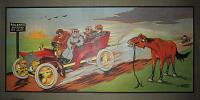
Procès-Verbal.
A. Molynk.
[n.d., c.1905.]
Rare chromolithograph. Sheet 440 x 895mm (17¼ x 35¼") with large margins. Wear to the edges.
An automobile with four passangers speeds past a tethered horse, a policeman with a sword running after it.
[Ref: 51407] £320.00
![[Car race.]](img-thumbnail/jpegs/51408.jpg)
[Car race.]
And. Nevil Juill. 05 [in plate]. ESA [mongram.]
A Été Imprime par La S.te des Établissements Artistiques Minot en Aout 1905 pour L'Estampe Sportive Artistique.
Rare chromolithograph in chine collé, signed in pencil by the artist. 490 x 780mm (19¼ x 30¾") with very large margins. Backing paper is damaged. With a stain near the signature.
An automobile racing down a country road, chased by a terrier, watched by crowds lining the road
[Ref: 51408] £520.00

Pedestrian Hobbyhorse. Exhibiting at 40, Brewer Street, Golden Square. M.r Johnson, Patentee, 75, Long Acre.
Pub.d by R. Ackermann, 101 Strand. Feb.y 1819.
Aquatint with very fine colour. Sheet 135 x 180mm (5¼ x 7"). Trimmed around image, laid on album paper.
A 'dandy horse', a primative bicycle on which the rider proceeded by pushing forward on the ground. Originally patented in 1818 in Germany by Baron Karl Drais, this is the ‘pedestrian curricle' of Denis Johnson (c.1760-1833), a coachbuilder of Long Acre who made at least 320 during the short craze for velocipedes in 1819. Like many crazes it was killed by a health warning. A variation of the print published in Ackermann's Repository of Arts
[Ref: 59404] £260.00
(£312.00 incl.VAT)

Pedestrian Hobbyhorse. Mr. Johnson, Patentee, 75, Long Acre.
Published Feb.y 1819, at R. Ackermann's, 101 Strand.
Coloured aquatint with very fine colour. 152 x 216mm (6 x 8½"). Mark top right.
The hobbyhorse was a toy used by children dating back to the 1300s. The vehicle depicted here is more akin to the velocipede (also known as the 'dandy horse'), on which the rider proceeded by pushing forwards with his/her feet. Ackermann's Repository of Arts was an influential illustrated periodical published from in London from 1809-1829 by Rudolph Ackermann. The formal title of the publication was "Respository of Arts, Literature, Commerce, Manufactures, Fashions, and Politics".
[Ref: 56180] £320.00
![[Man riding a penny farthing.]](img-thumbnail/jpegs/8925.jpg)
[Man riding a penny farthing.]
Frank Allport [signed in ink lower left.]
[n.d., c.1880.]
Pen and ink and watercolour, sheet 255 x 205mm. 10 x 8".
An original caricature sketch of a man with a demonic beard, moustache and extraordinarily shaped hair with pony tail riding a penny farthing bicycle. The ordinary, high wheel or penny-farthing was the first true bicycle with which actual speed and distance could be achieved in a practical manner. Based on the original French Boneshaker, James Starley and others produced bicycles with front wheels of ever increasing size, starting about 1870.
[Ref: 8925] £320.00
![[Das Wagenrennen vor der Stadt.] [or]](img-thumbnail/jpegs/63055.jpg)
[Das Wagenrennen vor der Stadt.] [or] [Telega at the entrance of a village]
A. Orlowskj 1824.
Lithograph, sheet 345 x 475mm (13¾ x 18¾"). Repaired tears in margins and creases.
A telega race; a type of four-wheel horse-drawn vehicle, whose primary purpose is to carry loads, similar to a wain. Aleksander Orlowski (1777 –1832) was a Polish painter and sketch artist, and a pioneer of lithography in the Russian Empire.
[Ref: 63055] £290.00
(£348.00 incl.VAT)
![[Sedan chair and horse fall into water]](img-thumbnail/jpegs/44224.jpg)
[Sedan chair and horse fall into water]
[Anon., c.1800]
Etching, unique & rare; sheet 340 x 290mm (13½ x 11½"). Trimmed; tears to edges; glued to backing sheet; another impression of same plate verso of same plate.
[Ref: 44224] £260.00
(£312.00 incl.VAT)

The Motor Car. Words by Richard Morton, Adapted to the Meolody of ''Funiculi Funicula'' by L. Denza. Sung with Great Success by John F. Sheridan.
Ricordi's Copyright 1897.
Pamphlet; pp. (8), cover with chromolithographic portrait. 350 x 255mm (13¾ x 10"). Cover detatched, some soiling.
The words and music of a comic song about an attempt to drive a motor car from Camberwell to Brighton, ending with the car exploding. The cover depicts John Francis Sheridan (1843-1908), an Irish-American comic actor, dressed as a Chinaman, carrying a pole with two scenes from the song. He ended his career in Australia, dying in a hotel in Newcastle. Very rare & early Motor Car item, Brighton interest.
[Ref: 58854] £490.00

Schlitten=fahrt auf der Elbe. 36
Kliedertracht u. Gebrauche in Hamburg.
Fine coloured aquatint; Sheet 175 x 265mm (6¾ x 10½"). Trimmed to image, small tear top right.
'A Sleigh-Ride on the Elbe'. A horse-drawn sleigh driven by a man seated on the back, a woman passenger under a leopard-skin, the outline of Hamburg in the background.
[Ref: 37989] £80.00
(£96.00 incl.VAT)

The New Steam Carriage... It has been constructed by Mr Goldsworthy Gurney, the Inventor and Patentee.
G. Morton Del.t. Pyall Sculp.t.
Published by Thos. Mc.Lean, 26 Haymarket.London. [n.d., c.1828.]
Coloured aquatint. 300 x 440mm (12 x 17¼"). Time staining at edges, very slight central crease.
A large steam-driven coach passing an ale-house on the London to Bath road, with passengers including a kilted soldier. In the background are amazed spectators and a windmill. In July 1829 a steam coach built by Sir Goldsworthy Gurney (1793-1875) ran from London to Bath and back at an average speed of 14mph, double that of a horse-draen coach. However the introduction of heavy tolls for his vehicles and Gurney was bankrupted with debts of £232,000.
[Ref: 49010] £680.00

The New Steam Carriage!!
[n.d., c.1828.]
Coloured aquatint, scarce. Printed border 115 x 215mm (4½ x 8½"). Trimmed, title excised and replaced, laid on album paper.
A large steam-driven road vehicle, with a driver and eight passengers, overtaking a horse-drawn coach. A scene with a similar carriage, but with an ale house looming large, was engraved by Pyall after G. Morton and published by McLean c.1828.
[Ref: 44561] £390.00
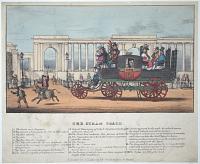
The Steam Coach.
[G. Davis.]
Published by J. Didsbury 22 Southampton St. Strand. [n.d., c.1820.]
Extremely scarce lithograph, with hand colour. Sheet size: 235 x 285mm (9¼ x 11¼"). Diagonal crease and small stains.
Goldsworthy Gurney’s Steam Carriage passing the gates of Hyde Park, with passengers onboard including a mother and child peeping out through the window of the carriage in the centre, and a boy playing a trumpet towards the front. There are four chimneys at the rear of the coach. Passers by, including one figure on a donkey, can be seen looking at the coach.
[Ref: 52100] £480.00
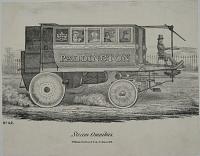
Steam Omnibus.
J. R. Barfoot.
William Darton & Son, Holborn Hill. [n.d., c.1840.]
Lithograph, sheet 170 x 215mm. 6¾ x 8½". Sheet trimmed, laid onto album page.
A steam omnibus operating on the Paddington to City of London service. Despite the introduction of the first steam omnibus in 1833, horse-drawn buses, first introduced in London in 1829, remained more common and survived until 1912 when they were superseded by the new motorised omnibuses. Numbered 'No.42' lower left.
[Ref: 14856] £110.00
(£132.00 incl.VAT)
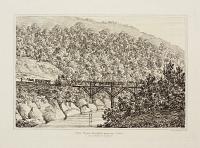
The Tram Bridge over the Tawe.
Drawn & Etched by I.G. Wood.
London Published by Ino. Geo. Wood. 1817.
Soft ground etching. Plate: 180 x 250mm (7 x 9¾"), with large margins.
A view of the horsetram bridge built over the river Tawe in Wales. The horse tram was started in Britain on the Swansea and Mumbles railway and used specifically for tramlines and carriages to transport goods and people.
[Ref: 46302] £50.00
(£60.00 incl.VAT)
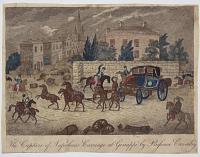
The Capture of Napoleon's Carriage at Genappe by Prussian Cavalry.
[Anon, c.1815]
Engraving with hand-colouring, rare; sheet 150 x 195mm (6 x 7¾"), Trimmed around image and title; glued to album sheet.
Following the Battle of Waterloo, Johannes Horn, who drove Napoleon's coach (or 'dormeuse') tried to bring the vehicle to safety. He drove from La Belle Alliance to near Genappe where the Prussian cavalry captured the carriage and left Horn for dead. The aftermath of the battle is suggested by the scattered cannons, barrels and cannonballs.
[Ref: 32294] £120.00
(£144.00 incl.VAT)
<<< Previous 1 Next >>>





![[St. Paul's Cathedral from Fleet Street.]](img-thumbnail/jpegs/12085.jpg)






![[Moto-Fuite.]](img-thumbnail/jpegs/51404.jpg)

![[Car race.]](img-thumbnail/jpegs/51408.jpg)


![[Man riding a penny farthing.]](img-thumbnail/jpegs/8925.jpg)
![[Das Wagenrennen vor der Stadt.] [or]](img-thumbnail/jpegs/63055.jpg)
![[Sedan chair and horse fall into water]](img-thumbnail/jpegs/44224.jpg)







